#and now you know
Text
Monster Art History: The Wendigo
You may be wondering why the wendigo, which has become very popular in pop culture over the last 10 years or so, is usually depicted in Western sources with a deer head. This appears nowhere in Native American traditions, despite the creature having lots of folkloric variations. The association of the wendigo with deer is 100% Western, 100% modern, and has a long, weird history.
Just in case you need a primer, the windigo or witiko is a supernatural being from the Algonquin speaking nations of the eastern American continent. It appears as an emaciated figure, sometimes giant, sometimes covered in ice, sometimes both. In many stories, they have a literal heart of ice. Windigos are manifestations of cannibalism and winter, and hunt, kill and eat people. Someone who resorts to cannibalism to survive, or otherwise abandons their community for personal gain, will become one of them. A few stories tell of someone being “cured” and turned back into a human, but usually the only cure is to kill the monster. In the last several decades, native writers have associated windigos with capitalism and deforestation as an extension of their selfishness. If you would like to know more about the properly Native windigo in context, I recommend Dangerous Spirits: The Windigo in Myth and History by Shawn Smallman.
The creature first came into horror fiction with Algernon Blackwood’s “The Wendigo”. Note the spelling, which would become the standard in horror, and generally in non-academic Western sources. In that story, it is not associated with cannibalism, but instead is a more generic “evil spirit of nature”. This wendigo stalks white people in the wilderness and turns a Native character into a new wendigo by seizing them and flying with them into the sky. This definitely better fits fears about non white people, fears about nature, and how the one is closer to the other than “civilized” people. Its description in the story is vague (the most we get is that it has burned its feet away by running into the sky). But when the story appeared in Weird Tales in the 1930s, Virgil Finlay illustrated it like this, the first antlered wendigo I know of.

This story was ripped off by August Derleth, a prominent Weird author in the 1940s and the main popularizer of HP Lovecraft. In his Cthulhu Mythos stories, he introduces Ithaqua the Wind Walker, which is an alien version of Blackwood’s monster. This fits into Derleth’s vision of the gods and monsters of HP Lovecraft falling into the four classical elements, with Ithaqua being invented to represent Air. Ithaqua is usually depicted as an icy, emaciated giant, so ironically is one of the more accurate wendigos to Indigeonous beliefs in pop culture.
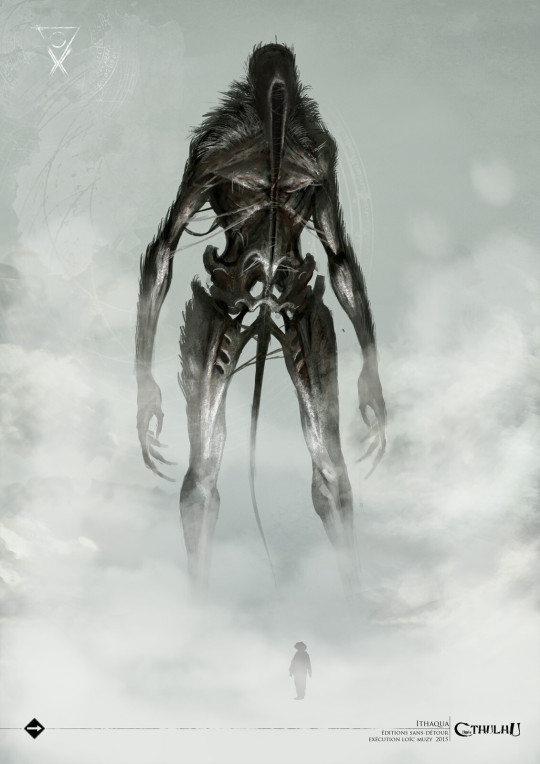
Image from a recent French edition of Call of Cthulhu RPG, by Loic Muzy
In Pet Sematary, Stephen King uses a wendigo as the reason for why the titular cemetery is cursed. This is an update of the classic racist trope of the “Indian Burial Ground”, except this time what gets buried there comes back animalistic and evil. The racist implications of that are pretty apparent. This wendigo is seen briefly and has ram’s horns. It does not appear in the first film adaptation, but does in the more recent one... with deer horns instead, because those are trendy right now.
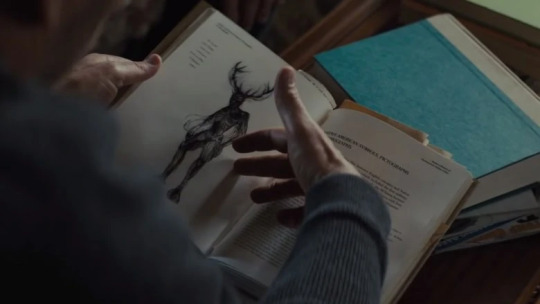
A good scholarly look at the real windigo versus the 20th century horror wendigo is “The Appropriation of the Windigo Spirit in Horror Literature” by Kallie Hunchman.
In the 1980s, a movie called Frostbiter: Wrath of the Wendigo was produced, but it wasn’t released until 1995 by Troma. From what I’ve read, it’s a pretty transparent ripoff of Evil Dead 2, with the characters being picked off in a haunted cabin with a zombie in the basement. The “twist” is that the origin of the horrors is a wendigo released by breaking a Christian demonology-style sacred circle. This wendigo is realized in stop motion animation, and has the most deer-like body yet.

A number of other independent horror movies in the 90s and 2000s used wendigos as a plot element. These follow the Blackwood/King approach of having the wendigo being something evil, ancient and Native American, reflecting white anxieties about living on stolen land more than Native anxieties about cannibalism and greed. Wendigo (2001) has the creature sicced on a white family when they hit a deer with their car. The Last Winter (2006) posits that global warming and fossil fuel extraction have unleashed the ghosts of dead animals, which are wendigo apparently, to revenge themselves on mankind. Which approaches the idea that greed is wendigo sickness, but I don’t think intentionally as a reference to modern Native literature. The “wendigo” in this movie are spectral moose and caribou.

The mainstream breakthrough of the deer-headed wendigo was in, appropriately enough for this blog, Pathfinder RPG. In “Spires of Xin-Shalast”, the last volume of Rise of the Runelords published in 2008, a wendigo is a major encounter. I suspect that either the author (Greg A. Vaughn), or one of the editorial staff had seen Frostbiter, as the setup involves a cabin haunted by dwarven cannibal ghosts who all killed and ate each other due to a wendigo’s influence. This wendigo is a hybrid of the Blackwood and Cree versions in terms of its MO: it is a cannibal ice spirit that wants to make more cannibals, and does so by abducting people and running off into the sky with them. Its design is the standard for what most Western artists depict wendigos as these days: an emaciated humanoid with the head and antlers of a deer (and the burned off feet of Algernon Blackwood, which are less common):
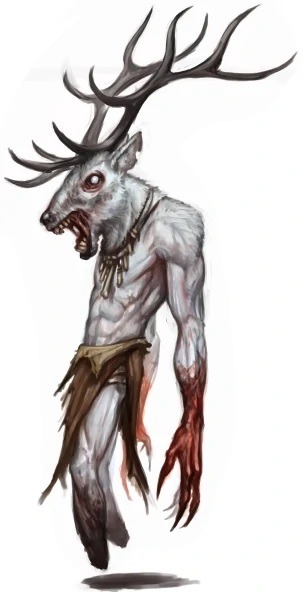
Image by Tyler Walpole, © Paizo Publishing
This wendigo definitely made a splash at the time; it was the first time I remember seeing a deer-headed wendigo, and art of that design started to become common. It pushed away previous wendigo depictions, which were typically werewolves (as French Canadian trappers had blended the concept with their own loup-garou, and Werewolf the Apocalypse had a whole faction of racist Native American “wendigos”) or shaggy and ape like (based more on the look of the Marvel Comics villain).
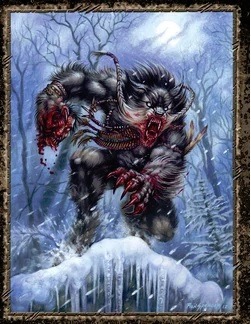
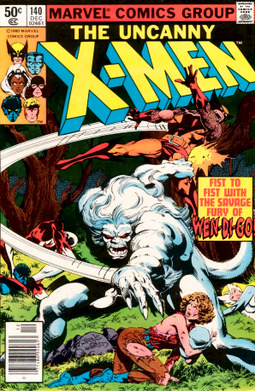
What turned wendigos from “folklore/horror monster” to “fandom blorbo” was Hannibal, which first aired in 2013. In that series, the first murder is a woman’s body impaled on a stag’s head, after which protagonist Will Graham has visions of a black stag, and a man with the antlers of a stag, representing murder, evil, and of course the cannibalistic murderer Hannibal Lecter.

Since Hannibal was super popular with the shipping fandom set, wendigo themed characters became popular in its wake, creating a wholly new way to culturally appropriate the wendigo. This was magnified by Over the Garden Wall, which came out in 2014, and its villain The Beast. The Beast is never called a wendigo, but is an antlered giant associated with winter, and so is commonly head-canoned as a wendigo and associated with them in fandom circles.

Which gets us to the modern day, where teenagers have misunderstood wendigo OCs, any character with antlers can be called a wendigo on the internet, and actual First Nations people with an actual cultural connection to the legend wish that people would just knock it off.
#and now you know#wendigo#windigo#witiko#creature design#art history#pathfinder rpg#algernon blackwood#august derleth#cthulhu mythos#stephen king#b movies#stop motion#hannibal#native american#first nations#cultural appropriation#long post
2K notes
·
View notes
Note
What was that crazy music video type thing you included on that post about ALW being an ass to Patti Lupone? I have never seen that before and I am both intrigued and horrified. I only recently got into Phantom, and all this craziness is just delighting me. 😂
For context, this is the video referred to in this ask:
youtube
This was a promo video done in 1985 (I think), to promote Phantom. Those are the original lyrics by Richard Stilgoe, which he wrote before Charles Hart was involved. You'll recognize a few here and there, but a lot of them are... weird, to say the least (weird enough for Cameron "Satan" Mackintosh to tell ALW to either find someone to help out Stilgoe, either outright fire him, or else he wouldn't produce Phantom anymore. And given it was proving to be a VERY costly show to make, even ALW knew losing CamMack was a no-no).
The staging is also different, because Trevor Nunn was the director at this point. And that's another funny (HA) story: ALW and Cameron Mackintosh had initially got Hal Prince to direct. And for those of you who don't know, Hal Prince is basically to musicals what Steven Spielberg is to cinema. He directed some of the most successful musicals of the latter half of the 20th century: Evita, Sweeney Todd, Fiddler on the Roof, West Side Story, Cabaret, Company... and that's the list of musicals I know even the uninitiated will recognize. So one day, on a whim, ALW decided to fire Hal Prince, which went about as well as you might expect: ALW chickened out of the dinner where he and CamMack were supposed to break the news to him, which led to CamMack having to sheepishly break the news to Hal Prince, who stormed out furious (AS HE SHOULD). Again, imagine yourself firing Steven Spielberg from making Saving Private Ryan and replacing him with, I dunno, the Russo brothers because The Avengers made a shit ton of money.
Why? My guess is that Hal Prince had the balls to tell ALW to stick it whenever he'd bring bad ideas on the table, so ALW basically decided to replace Hal Prince with the director for one of his previous musicals, Trevor Nunn (who is a decent director, mind you, making the comparison to the Russo brothers a little harsh).
Which musical was it, mind you? CATS.
IT ALWAYS COMES BACK TO CATS.
And Steve Harley? He was a rock singer who got picked up along the way because they urgently needed someone to play the Phantom in the music video, and full offense but he's a worse singer than Gerald Butler in my opinion, and at least the latter could actually act. ALW realized that they needed someone else, and he basically smuggled the score to a comedic actor called Michael Crawford, who had some prior experience singing in musicals (he's in the film adaptations of A Funny Thing Happened on the Way to the Forum and Hello Dolly, if you're interested), but he wasn't exactly the guy you'd think of for the Phantom? Thankfully, he proved everyone who might have doubted him wrong, and amazingly at that, but he was a gamble at the time nonetheless.
And as you may guess, the music video was kind of poorly received, and Trevor Nunn worked on a little musical called Les Misérables, which got piss poor reviews and ALW was at the head of them (CLASS ACT, THAT FELLOW). But the uneducated, unwashed plebs loved it so I guess that's the reason why it's still playing today, and not because it's one of the most beautiful scores ever written for musical theatre, summing up a 1,000 book perfectly and conveying emotions that could make angels cry, nah. /s Anyway, that led to ALW firing Trevor Nunn, and begging Hal Prince to come back, and he agreed - which really goes to show how gracious he is because I would have laughed in ALW's face.
And what happened to Steve Harley, you may ask? He found out with a call from CamMack that he was fired, with no explanation whatsoever, and it was only later that he found out Michael Crawford had replaced him. I mean, was it for the best? Yeah. Do I still feel kind of bad for Steve Harley? Yeah.
So yeah, thank your lucky stars Hal Prince, Charles Hart and Michael Crawford agreed to be in this. I'd also add Maria Bjornson, but I really wonder now how she got involved in the first place because if that came from ALW, that might be the single best decision he ever made in his entire life. But I don't have any trust in him whatsoever to pull that off lmao
#lord-valery-mimes#phantom of the opera#Andrew Lloyd Webber#Hal Prince#Cameron Mackintosh#Charles Hart#Richard Stilgoe#Trevor Nunn#Michael Crawford#Steve Harley#and now you know
104 notes
·
View notes
Text
Part 1: Dial B for Braincell by Bunnywest
Summary:
Peter stares at the phone in dismay. Shit. “I-“ Peter clears his throat. “Apologies. I appear to have the wrong number.”
There’s a chuckle. “No shit, Sherlock. And who the hell doesn’t know what Machu Picchu is?”
Peter relaxes somewhat at not getting blasted, and sighs. “My date. He was pretty, but brain-dead.”
The voice on the other end makes a sympathetic sound. “Wanna talk about it?”
Tags: Pre-Slash, Wrong number, Meet-Cute
Published: 2020-03-30
Words: 979
Chapters: 1/1
Part 2: And Now You Know by Bunnywest
Summary:
Peter and Stiles have been dating for three months now, and Peter still hasn't told Stiles he's a werewolf.
That's all about to change.
Tags: Established Relationship, Werewolf Reveal, Good Peter Hale, Lawyer Peter Hale, Stiles Stilinski Knows About Werewolves
Published: 2020-08-13
Words: 2,833
Chapters: 1/1
Rating: n/A
8 notes
·
View notes
Note
wait. mya wasn't in the original comic where jorge was a ginger?
She fell out of existence for the comic strip XD

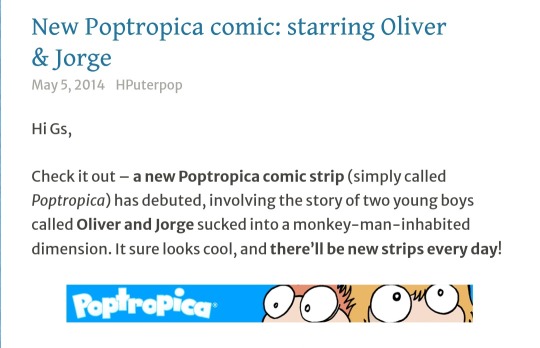
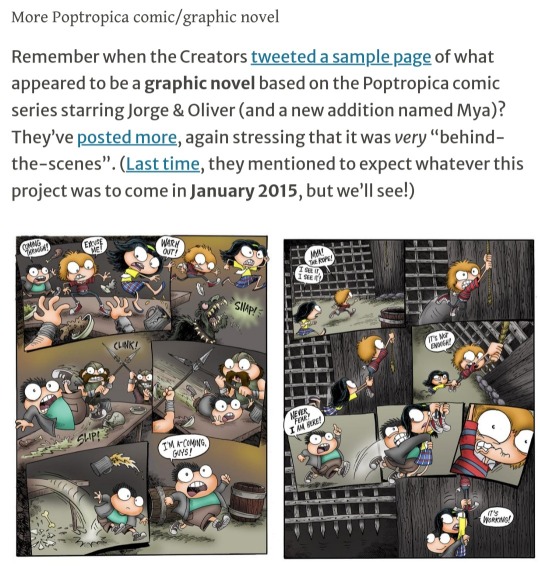

(They spelled her name wrong, lol)
#and now you know#ask#poptropica#poptropica comic strip#mya hartman wong#poptropica mya#oliver hartman wong#poptropica oliver#jorge flores#poptropica jorge flores#motm#mystery of the map#poptropica graphic novels
7 notes
·
View notes
Text
A year ago I started writing a fic where Armstrong topped Sundowner because I wanted to mess around with the idea of robogenitals and y’know power dynamics and allat but I stopped after a scene where Armstrong slapped his ass and took note of how it sounded like hitting an exercise ball
6 notes
·
View notes
Text

Soon it will come.
It will arrive in our world.
This very month.
#dougie rambles#personal stuff#my poor attempt at a joke#idol of eirræbœ#Eirræbœ#analog horror#shitpost#schizoposting#infohazard#and now you know#unreality#nightmare fuel#oddly terrifying#Amygdalum#christmas#soon#no context#highbrow shitposting#this sounded funnier in my head#what#i am so sorry#truly#omen#herald#it is coming#bear witness#the horrors#planned obsolescence#signs#weapons grade shitpost
9 notes
·
View notes
Text
We Walk Into A Bar
so there's this post which talks about the earliest known example of a bar joke ("x walks into a bar and...") which no one knows or understands the punch line of, if it even has one, since it's a proverb.
it is followed up by selected screencaps of a (now deleted) thread wherein someone claims to have deciphered it all (with - also deleted - linguistic receipts) and figured out the pun.
with me so far?
okay let's go down a rabbit hole.
How We Found Out: https://www.tumblr.com/bending-sickle/723007901258711040
We Know Nothing: https://en.wikipedia.org/wiki/Bar_joke
“[Assyriologist Dr. Seraina] Nett suggests that the punchline could be a pun that is incomprehensible to modern readers, or a reference to some figure who was well known at the time but similarly unfamiliar to us today. Gonzalo Rubio, another Assyriologist, cautions that this ambiguity ultimately means it is simply not possible to definitely categorize the proverb as a joke, though he and other scholars like Nett do point to the recurring use of innuendo in such proverbs as indicating that many were indeed intended to be humorous.”
We Know Nothing, Part 2: Podcast Boogaloo
“What makes the world’s first bar joke funny? No one knows.” Endless Thread podcast, August 5, 2022 https://www.wbur.org/endlessthread/2022/08/05/sumerian-joke-one
Hosts: Amory Siverston & Ben Brock Johnson
Guests:
Dr. Seriana Nett (Assyriologist and researcher at the Department of Linguistics and Philology at Uppsala University, Sweden)
Dr. Gonzalo Rubio (Assyriologist and Associate Professor of Classics & Ancient Mediterranean Studies at Pennsylvania State University, USA)
Dr. Philip Jones (Associate Curator and Keeper of Collections of the Babylonian section at the University of Pennsylvania Museum of Archaeology and Anthropology, a.k.a. the Penn Museum, USA).
Excerpts:
Amory: Seraina Nett works at Uppsala University in Sweden, where she studies ancient Mesopotamia, including a region called Sumer and its language Sumerian. She spends a lot of time translating Sumerian, looking for clues about early human development.
[…]
Ben: Seraina was one of several thousands of people who happened upon this joke in March on Reddit and initially on Twitter.
Amory: That’s where the account @DepthsOfWiki posted a screenshot from an unlinked, unnamed Wikipedia page. It reads like this: “One of the earliest examples of bar jokes is Sumerian, and it features a dog.”
[…]
Amory: The humor of the dog-in-a-bar joke was probably related to those Sumerian ways of life, perhaps the middle class or well-off, people with downtime and drinking shekels.
Ben: But while some experts know some things about Sumer, the nuances have been lost, and it’s the nuances that bring jokes to life.
[…]
Seraina: It could have been a pun that we don’t understand. It could have been a reference, I don’t know, to a local politician or some famous figure. So it’s very hard for us to tell.
[…]
Seraina: This proverb is in no way special. It’s part of a larger collection of many, many, many proverbs.
Amory: The bar joke — or proverb — is Number 5.77 in a collection of hundreds of other proverbs about dogs, donkeys, husbands. Some read like sayings. Others like weird short stories. But jokes? Depends on how you see things. Like this other proverb Gonzalo told us:
Gonzalo: It’s something like, “Behold! Watch out! Something that has never occurred since time immemorial; the young woman did not fart in her husband’s lap.”
Ben: Sorry, I’m going to be really dumb for a second.
Amory: I am too because this is—
Ben: I’m not sure I get the joke. Is the joke that the woman would never admit that she farted in her husband’s lap? Or is the joke that the woman always farts in her husband’s lap? And that’s the joke, that we’re suggesting that it’s never happened before.
Gonzalo: I think the joke is precisely the latter. The joke is that it is expected to happen. To set up the joke by saying, “Watch out, this is something that has never happened, not once.” And then the sentence is, well, “The young woman did not fart in her husband’s lap.”
[…]
Seraina: There’s quite a lot of innuendo — things like sexuality or, I don’t know, excrement. For example, one of my favorite ones is, “A bull with diarrhea leaves a long trail.”
[…]
Gonzalo: The word for tavern, “ec-dam,” for us, it conveys the idea of a pub or a bar. But really, in ancient Mesopotamia, a tavern is also a place where sex trade takes place. So it’s a tavern, but you could also translate it as a brothel.
[…]
Seraina: It could have been the dog walks into the bar with his eyes closed; “Let me open this,” as in the eyes. Or open, I don’t know, a door. There is also a word that sounds very similar to one of the words that is a word for female genitalia.
[…]
Ben: There’s another complication, though, because it still doesn’t make sense. Or, at least, we’re not laughing. Plus, the translations are too loose and feel kind of unreliable. We mentioned this to Seraina, who dropped one more tantalizing clue about the clay tablet — or tablets that hold our proverb.
Seraina: So this particular proverb is attested on two different versions of the text. And actually, they’re not identical. So, already, somebody screwed up. One of them is also a little bit broken, so it’s hard to tell.
Amory: This thing that everyone’s struggling to understand: No fricken wonder! Because there are two copies. They’re actually both broken, and they don’t match.
[…]
Ben: These two ancient tablets, he tells us, were etched around 1700 B.C.E. At first, this means nothing to us, really, but Phil explains. By that time, Sumer had actually been overtaken by the Babylonian empire. The culture was pretty similar, except that the Sumerian language had already died out.
Amory: Kids at the time spoke Babylonian, also called Akkadian. Only scribes continued to learn Sumerian. It was considered more dignified — kind of like learning Latin today. Knowing this, it seems now even more likely to us that there are mistakes in the text. For instance:
[…]
Ben: Ignoring the random non-Sumerian word, the dog enters the taverny brothel or brothely tavern. He can’t see a thing. He opens this one. Only, Phil says the word “open” is very similar to the word for “close.”
Phil: I mean, not in this case. I think it obviously means to—. Well? It obviously means to open in this case because they do spell—
Amory: Are you sure?
Ben: Yeah, you sound unsure.
Phil: I think I’m fairly sure because normally, if they mean “to close,” they’ve ended up using a different spelling than this one.
[…]
Amory: But he [Phil] adds that everyone’s missing some very important context about the dog.
Phil: The dog is a specific character type. It’s a guard dog whose job is to keep the wolves from the sheep. And in the proverbs, you know, it’s operating on the basis that it’s a personality type that is fairly brutal and not really to be messed with.
Ben: Interesting. That puts like a whole ‘nother layer on this thing because I feel like I wasn’t making any assumptions about the dog other than its general doggyness.
[…]
Phil: I think usually in proverbs, when they say “this,” it refers to something you’ve already heard in the proverb, not to something new. So I think the idea that he’s opening rooms and revealing, you know, couples in flagrante doesn’t quite go with how I would see the word “this” functioning. So I did wonder whether this is more the idea that letting the guard in negates his use because, basically, he wants to see out, he’s going to open the door, and so everybody else outside the tavern can now see in. I mean, I think that’s a legitimate way of looking at it.
Ben: Phil covers the old clay. We wistfully shuffle out. And, at this moment, we buy his theory. A brothel’s guard dog is sitting outside the door under the bright Sumerian sun. He’s scaring away unwelcome Peeping Toms. But then he leaves his post.
Amory: He goes inside, and his eyes aren’t used to the dark, so he can’t see anything. He opens the front door again, propping it to let in a little light. Now, outside, all those Toms are looking in, seeing their politicians and neighbors in flagrante, as Phil said. The guard dog messed up. Get it?
Reddit Redux: User serainan (Seraina Nett) To The Rescue
1 - https://www.reddit.com/r/AskHistorians/comments/tbgetc/this_bar_joke_from_ancient_sumer_has_been_making/
"We usually translate the word esh-dam as 'tavern'. Yes, they are associated with prostitution, but it is not primarily a brothel. There is eating and drinking and sex. So, the joke could be sexual, but doesn't necessarily have to be.
The verb ngal2--taka4 in its basic meaning means 'to open' without any sexual connotation. However, there's a noun gal4-la that sounds similar and means 'vulva', so there could be some double-entendre there...
Essentially, the interpretation of the proverb depends on the demonstrative 'ne-en' 'this' and what it refers to – grammatically, I'd agree with you and say it seems to refer to the eye, but there's really no way of knowing for sure.
The problem with jokes is really that they are so culture-specific. Maybe this joke makes fun of a local politician or it is using a very crude word that is not otherwise attested in our sources (written texts, particularly in ancient cultures, of course only cover a limited part of the vocabulary).
Bottom line: We don't get the joke! ;) ”
The Unknown and Deleted: A Story in Four Sources
1 - https://twitter.com/lmrwanda/status/1505648702119202823?t=IHkQWeElTa0T63o3lbr12Q&s=19
2 - https://twitter.com/lmrwanda/status/1505646738627088389?t=06aHTTZkf1ZaJyCDhWUzTg&s=19
3 - https://www.podchaser.com/podcasts/subversive-walex-kaschuta-1979505/episodes/lin-manuel-rwanda-the-twilight-158022618
4 - http://im1776.com/author/lin-manuel
There was one person on Twitter claiming the joke was, “A friendly dog walks into a bar. His eyes do not see anything. He should open them.” Or “He should crack one open.” (1) They add “It’s a ‘man walks into a bar and hurts his head’ tier dad joke, basically. The ‘pun’ in Sumerian is centered on the fact that the verb ‘to see’ also literally means ‘open (one’s) eye’.” This was at the end of a long word-by-word translation thread (which I can’t judge the quality of, and no other experts were chiming in) dated March 20, 2022 (2). I did not save the thread and Twitter is saying the page doesn’t exist anymore, so that’s a dead end now.
I hesitate to trust this source because I can’t find any of their qualifications (are they an assyriologist? A linguist? A candlestick maker?) and other experts in the field do not seem aware of this (if true) ground-breaking cracking of the highly-debated pun. (Dr. Seraina Nett’s gave an interview five months after this thread was made, and still called the actual pun a mystery.) I could only find out that their Twitter name is “Lin-Manuel Rwanda, @lmrwanda, Epistemic trespasser” and that, according to the podcast Subversive w/ Alex Kaschuta (December 14, 2022) (3), they are “a Twitter poster” with essays on the online magazine IM-1776, where they are credited as “Lin Manuel” (4). (Their introduction in the podcast also reveals they are a British national and resident, but the host is very coy about revealing even that. Lin Manuel corrects them, adding that they are “half Rwandan”, which explains the Twitter name. I am not listening to the whole hour and a half to look for more clues.)
#hey kids wanna learn about an obscure joke#you can see why i can't put this in a fanfic footnote#and putting it in an appendix is just...insane#anyway this has been eating my brain for a while#randomness#and now you know#a dog walks into a bar#linguistics
9 notes
·
View notes
Text
Update.
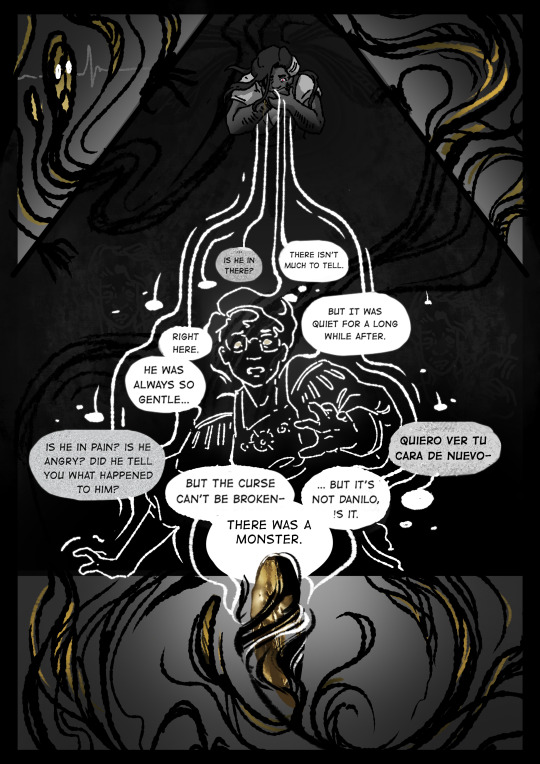
Whit didn't come back right.
Read it on Tapas // Read it On Webtoons
Click here for image IDs on all published pages.
Image ID for the promo in both the alt text and under the cut.
IMAGE ID: In the middle panel, Whit vomits speech bubbles. The strings flow through his fingers as he tries to keep it in and populate the rest of the page.
A ring of speech bubbles in the middle read, “... Is he in there?”, “There isn’t much to tell.” “But it was quiet for a long while after.”, “Quiero ver tu cara de nuevo-”, “Right here.”, “He was always so gentle…”, “Is he in pain? Is he angry? Did he tell you what happened to him?”, “But the curse can’t be broken-”, “... but it’s not Danilo, is it?”, and “There was a monster.”
In the center of the ring is a white-outlined sketch of Violeta from the sternum up, raising one hand, worry in every line. It isn’t that Whit is merely echoing what’s being said.
Whit mimics the exact sound of Violeta’s voice.
In the triangular panels in the top left and right corners of the page, Danilo stretches out, his line art stretching around the middle panel. The top right panel shows the formless gold sewn into abstract, flowing lineart. The top left panel shows Danilo’s shocked face, his white eyes wide with recognition.
Danilo’s body flows into the middle panel and is partially lost among the dark grey of the background and the faint outlines of the mask of Whit’s face embedded into the mudbender’s head from case 1, containing Whit’s soul.
The bottom panel shows a close up of Danilo’s head as several tails from the white speech bubbles wrap around the abstract black lines of his line art, as though attempting to put him back together. The gold color between the lines takes on a metallic sheen as Danilo’s original face is warped within the still-too-thin lines of his skull. End ID.
#bwbcomic#webtoon canvas#tapas comic#tapas webcomic#webtoon#original comic#monster art#body horror tw#came back wrong#supernatural#beasts without burden#and now you Know#that this is the update we've been most Excited for for a bit :)
19 notes
·
View notes
Text
I just want to say that when I wrote this
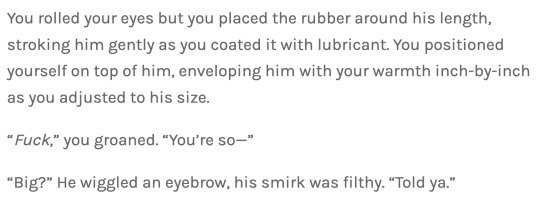
and this

or this

OR THIS

AND THIS

I wasn't exaggerating 😏
#and now you know#i have predicted this all along#BIG DICK EREN SUPREMACY#i'm going to bed i'll answer your asks and DMs tomorrow i just had to say this real quick LMAO#his dick is so big secret agent yn is running away from it let that thought sink in
135 notes
·
View notes
Text
While staring absently at Tumblr and occupying the system, instead of letting Sarah write her book, I managed to pull a long and thick nose hair out of our right nostril, and I feel so proud and satisfied with this feat.
That fucker is gone!
It was tickling us and very offensive.
2 notes
·
View notes
Text
WARNING: Discussion of sex
Ich: Also....ist Moros jetzt auf ihr Zimmer gekommen?
Viper: Ich weiß es nicht...Ich bin zwiegespalten.
Ich: Ok. Aber du solltest wissen dass [spoiler]
Viper: Ok sie haben Sex.
Ich: Also du musst jetzt nicht-
Viper: Nein, nein sie haben sex, sie haben sex. Eli bekommt 7 hickeys, wird hart pentriert und hat drei Orgasmen.
Ich: Das ging so schnell 👁👄👁
5 notes
·
View notes
Text
I have been playing Furry Paws, because I literally used to do Punnett squares for fun, and I’ve never seen another petsite with this much genetic experimentation power. And the art is cute.
Just now I sorted some dogs by level, because I wanted to see who was getting high enough level for me to breed. These are my highest-level Chihuahuas right now.

(side note: The three-letter code at the start of each name represents the dog’s current sports title. Then for the actual name, I generally either use one that amuses me, or just go with the in-game randomizer. There is one amusement name here and the rest are random.)
“Oh, but I’ve already bred Cody and Sophie,” I thought to myself. “I’ll take a look at the others, see if it looks like their genetics line up nicely.
“Ha! There’s a Buddy and a Holly. Oh, and they actually would go pretty well together. That would mean that, out of my basically-randomly-named Chihuahuas, the last potential breeding pair would be...
“.....,,.,.,,...,”
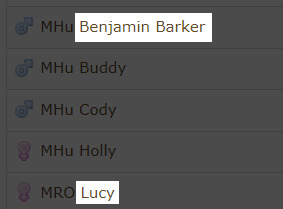
OH COME ON. I can’t put those two together, everyone will assume the names were on purpose!!
#ineffablefool original post#ineffablefool mentions furry paws#not good omens#why is this so funny to me#FOR PEOPLE WHO PLAY FURRY PAWS: yes i know you should breed at day 98 and day 110#but consider: these are game-generated dogs#i am not including any dogs that are not game-generated dogs#and if i have to wait for 1.000X leveling for three months before i can even start seeing generation 2 then i will turn to dust#and i am guessing my dust will probably not want to bother keeping up these breeding projects.#FOR PEOPLE WHO DON'T SEE WHY THE NAMES AMUSE ME: 'Buddy' and 'Holly' together make the name of a mid-last-century musician#remember that song Neil Gaiman said they were originally gonna use for the Good Omens opening credits? 'Everyday' by Buddy Holly#and then in the musical Sweeney Todd#a character who calls himself Benjamin Barker is very dramatically fixated on his lost wife Lucy#AND NOW YOU KNOW#all caps makes me cooler#so do extra tags#hey if any of my old repeat/possessed-of-nickname anons are still out there then random fact: i hope you have a very good next 24 hours <3
10 notes
·
View notes
Photo

How to draw Firmis
Step 1: Draw Firmis
#And now you know#art#myart#artists on tumblr#clip studio paint#oc tag#Firmis#Extant Universe#Entity OC#June 2022
28 notes
·
View notes
Text
planet gitaroo race headcanons
gitallines:
look exactly like normal humans
most of them are in the middle-class
might have met humans before the events of the game; human astronauts have named a town after their planet (that town is gitaroo town in stage 2 btw)
a "gitaroo man" is their version of a knight; the messenger of the king sends someone a weaponized gitaroo to fight against bad guys
were the ones who made the gitaroos; they shared them with the gravillains to be played as normal instruments, until some idiot decided they should be weaponized
gravillains:
look almost like humans, but they have one singular animal trait that throws you off (examples: zowie has bull horns, and gregorio has owl eyes)
most of them are upper-class
have never ever met humans before; refer to them as "aliens" (just like gregorio referring to kazuya in the collection menu)
have always coexisted with gitallines on planet gitaroo (there was an official backstory that stated there isn't a gravillain planet)
unlike their infamous empire, some gravillains are against using gitaroos for harmful purposes
2 notes
·
View notes
Text
as a Danish person I can confirm that the two genders are common and neutral.
#this is very funny#i promise#there were madculine and feminine in the middle ages#and still are in some dialects#but they merged in i think the 15th century#to become common#and neutral words are the words that were not part of this merging#common is about 2 thirds of all words#it is the more widely used one#and now you know
2 notes
·
View notes
Text
"Green’s Dictionary of Slang is the largest historical dictionary of English slang. Written by Jonathon Green over 17 years from 1993, it reached the printed page in 2010 in a three-volume set containing nearly 100,000 entries supported by over 400,000 citations from c. AD 1000 to the present day. The main focus of the dictionary is the coverage of over 500 years of slang from c. 1500 onwards.
The printed version of the dictionary received the Dartmouth Medal for outstanding works of reference from the American Library Association in 2012; [...] It has been hailed by the American New York Times as ‘the pièce de résistance of English slang studies’ and by the British Sunday Times as ‘a stupendous achievement, in range, meticulous scholarship, and not least entertainment value’.
On this website the dictionary is now available in updated online form for the first time, complete with advanced search tools enabling search by definition and history, and an expanded bibliography of slang sources from the early modern period to the present day. Since the print edition, nearly 60,000 quotations have been added, supporting 5,000 new senses in 2,500 new entries and sub-entries, of which around half are new slang terms from the last five years."
2 notes
·
View notes